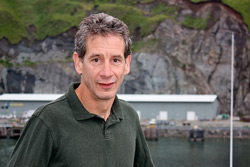
Kevin Arrigo.
A fundamental aspect of the Anthropocene is that there’s nowhere on Earth that is left unexplored; humans have now touched and altered every part of the planet. But the Arctic and the Antarctic remain some of the least understood parts of the world.
Kevin Arrigo, an oceanographer and professor at Stanford University, is one of the few people actively investigating the state of the polar regions. Much of his work relies on measurements from satellites, but occasionally he still ventures to the poles to “ground truth” his data. And what he finds there can come as a complete surprise.
Recently, during a NASA-funded trip to the Arctic to study nutrient cycling, Arrigo was part of a team that uncovered a hitherto unknown occurrence of undersea life — three feet below young Arctic sea ice. “Under that ice was productivity as high as you’d find anywhere in the world,” said Arrigo. The discovery attracted a lot of attention in the scientific community; previously, nobody thought so much primary production under the ice was possible. And it’s not something that could have been observed from space.
Does it look like this is a result of climate change? “That’s the big question,” said Arrigo. “There’s a lot of follow-up work to be done now.”
Arrigo sat down with me to talk about his recent discovery, other big shifts he’s witnessed in the Arctic, and changes in the ways we view, study, and use the ocean and the poles.
Free MP3. (Right click, select “Save Link As.”)
This interview is part of the Generation Anthropocene project, in which Stanford students partake in an inter-generational dialogue with scholars about living in an age when humans have become a major force shaping our world.



